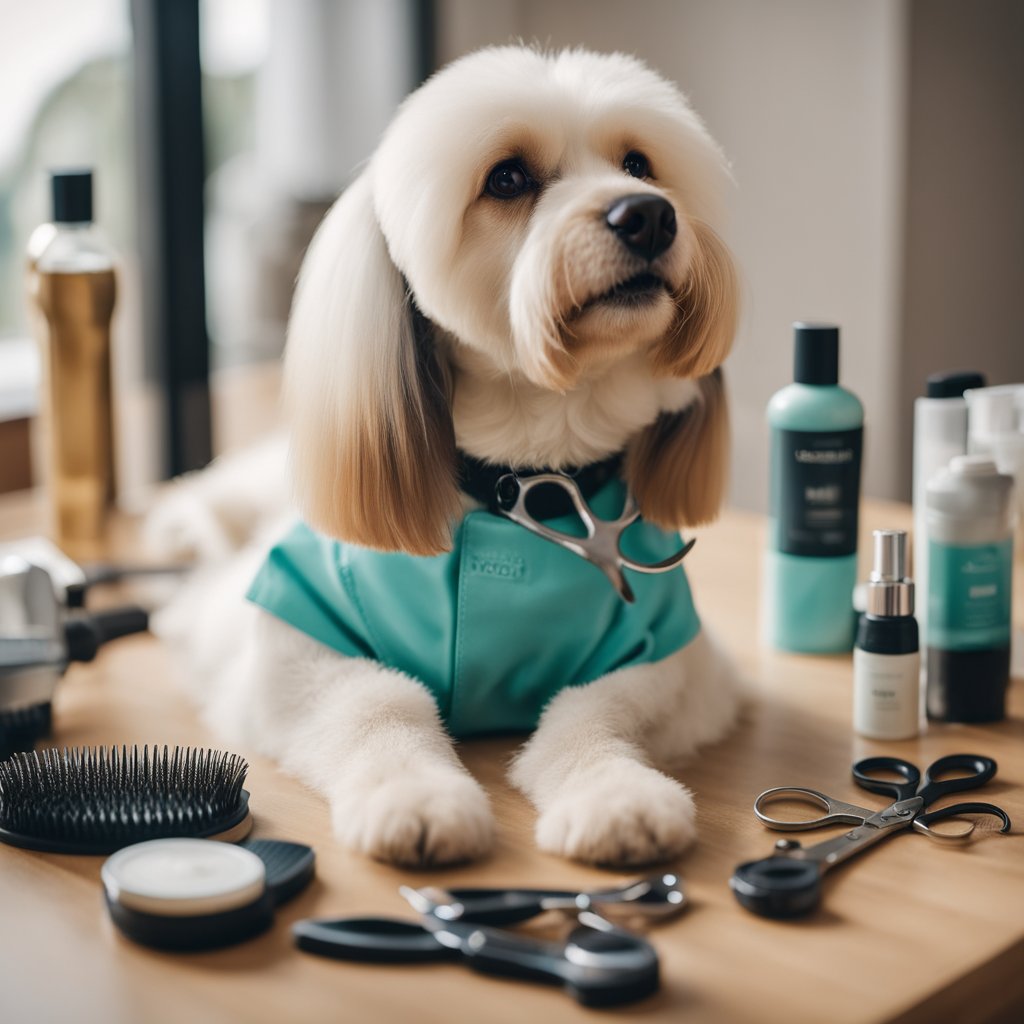How to Groom a Dog: Tips from a Professional Groomer
Grooming your dog is an essential part of pet care. Regular grooming sessions can help keep your dog’s coat and skin healthy, prevent matting and tangling, and reduce the risk of infections. However, grooming can be a daunting task, especially if you are a new pet parent. In this article, we will provide you with a comprehensive guide on how to groom your dog, from preparing your dog for grooming to post-grooming care.
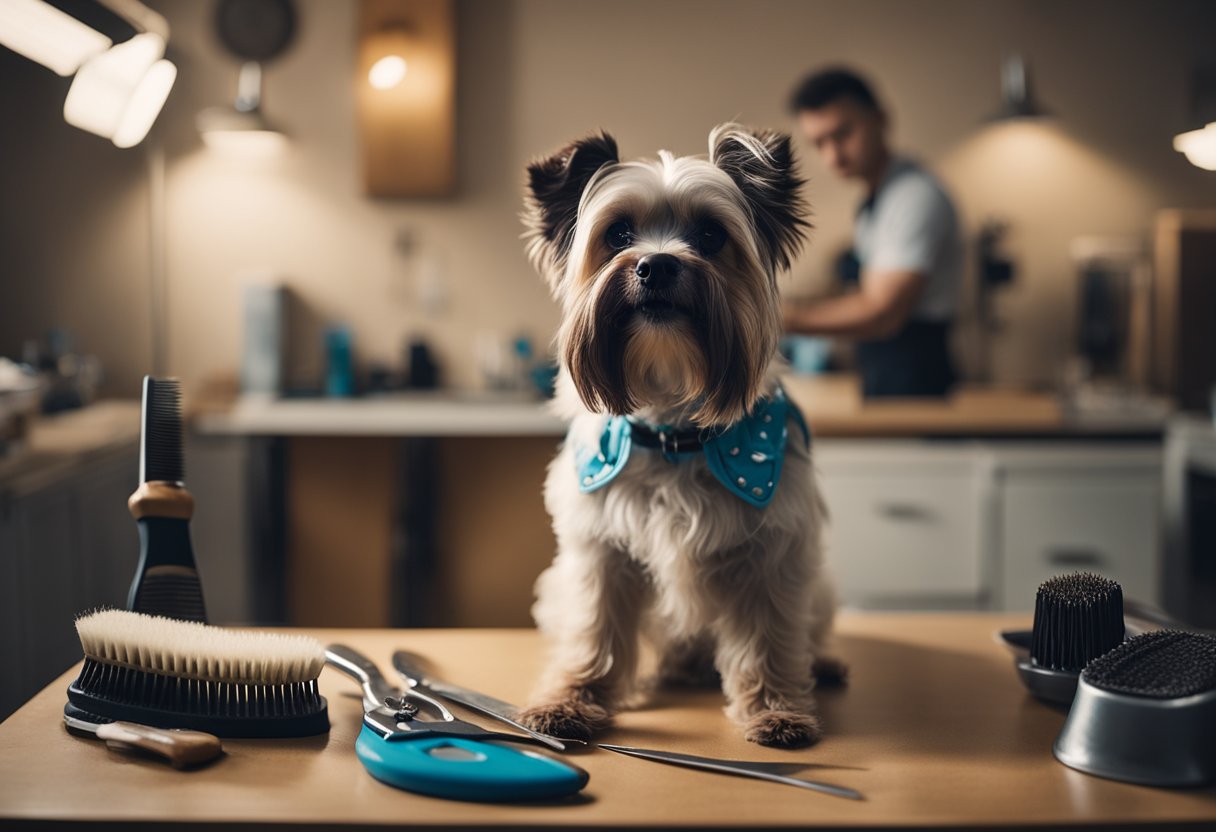
Before you start grooming your dog, it is important to prepare them for the session. This includes making sure they are comfortable and relaxed, and that you have all the necessary grooming supplies. Gathering grooming supplies such as brushes, combs, shampoos, and clippers beforehand can help make the process smoother and more efficient. Once you have everything you need, you can start with brushing techniques that are specific to your dog’s coat type.
Bathing your dog is an important part of grooming and can help keep their coat clean and healthy. However, it is essential to use the right shampoo and to avoid getting water in their ears and eyes. After bathing, you can move on to hair trimming and nail clipping. It is important to be gentle and cautious during these tasks to avoid injuring your dog. Finally, we will discuss post-grooming care and resources that can help you maintain your dog’s coat and skin health.
Key Takeaways
- Preparing your dog for grooming includes making sure they are comfortable and relaxed and gathering all necessary grooming supplies.
- Brushing techniques should be specific to your dog’s coat type.
- Bathing, hair trimming, and nail clipping should be done with caution and care to avoid injuring your dog.
Preparing Your Dog for Grooming
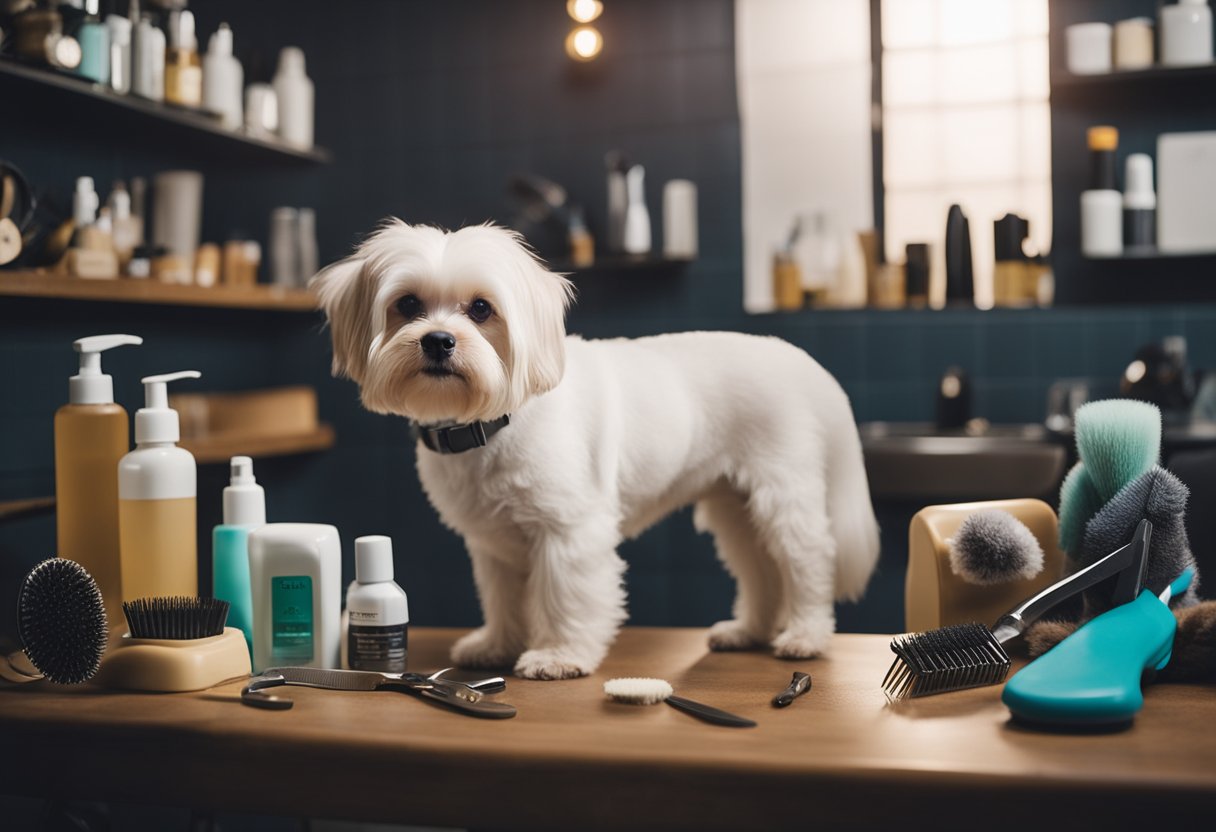
Before you start grooming your dog, it is important to prepare them for the process. Here are some steps you can take to ensure your dog is calm and relaxed during grooming:
1. Exercise Your Dog
Taking your dog for a walk or playing with them before grooming can help them release any pent-up energy and calm them down. A tired dog is more likely to sit still during grooming.
2. Choose a Quiet Location
Find a quiet location where you can groom your dog without any distractions. This will help your dog stay focused on you and the grooming process.
3. Gather Your Grooming Supplies
Make sure you have all the necessary grooming supplies before you start. This includes a brush, comb, scissors, nail clippers, and shampoo. Keep them within reach so you don’t have to leave your dog unattended.
4. Start Slowly
Introduce your dog to the grooming tools slowly. Let them sniff and investigate the tools before you start using them. This will help your dog feel more comfortable and less anxious.
5. Use Positive Reinforcement
Reward your dog with treats and praise throughout the grooming process. This will help them associate grooming with positive experiences and make them more willing to cooperate in the future.
By following these steps, you can help your dog feel calm and comfortable during grooming. This will make the process easier for both you and your furry friend.
Gathering Grooming Supplies
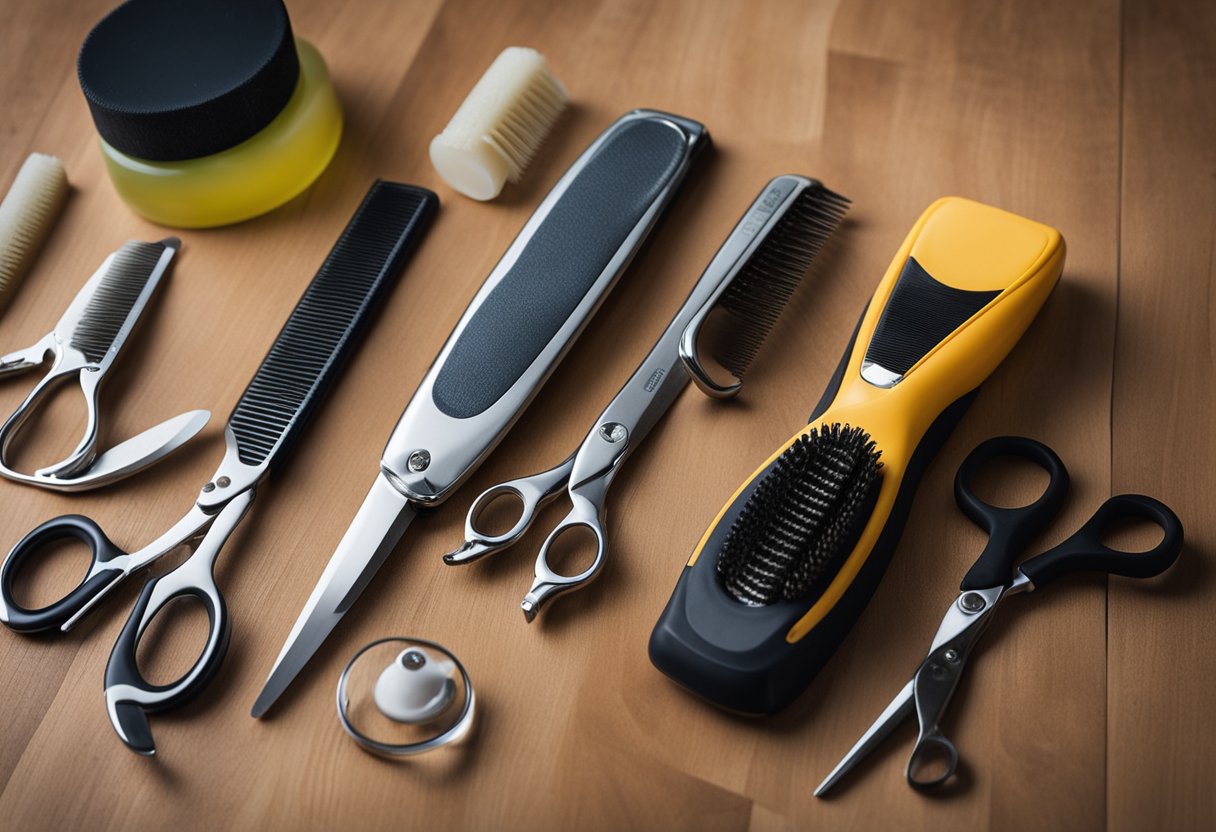
When it comes to grooming supplies for your dog, there are a few essential items you’ll need to have on hand. Here are the most important ones to consider:
Brushes and Combs
Brushes and combs are essential for keeping your dog’s coat looking healthy and shiny. Different coat types require different types of brushes and combs, so make sure you choose the right ones for your dog. For example, a slicker brush is great for removing tangles and mats from long-haired breeds, while a bristle brush is better for short-haired breeds.
Shampoos and Conditioners
Using the right shampoo and conditioner is important for maintaining your dog’s coat and skin health. Look for a shampoo that is specifically formulated for dogs and avoid using human shampoo, which can be too harsh for their skin. Conditioner can help to detangle your dog’s coat and make it easier to brush.
Grooming Clippers
If you plan on trimming your dog’s hair at home, you’ll need a good set of grooming clippers. Look for clippers that are designed for dogs and have detachable blades for easy cleaning and maintenance.
Scissors and Shears
Scissors and shears are helpful for trimming your dog’s hair in hard-to-reach areas, such as around the ears and paws. Make sure you choose scissors that are designed for dog grooming and are comfortable to hold.
Nail Clippers
Keeping your dog’s nails trimmed is important for their health and comfort. Look for nail clippers that are designed for dogs and have a safety guard to prevent over-cutting.
Grooming Table
A grooming table can be helpful for keeping your dog still and secure during grooming sessions. Look for a table that is sturdy and has a non-slip surface to prevent your dog from slipping or falling.
Remember to choose high-quality supplies that are appropriate for your dog’s breed and coat type. With the right tools and a little practice, you can become a pro at grooming your furry friend at home.
Brushing Techniques
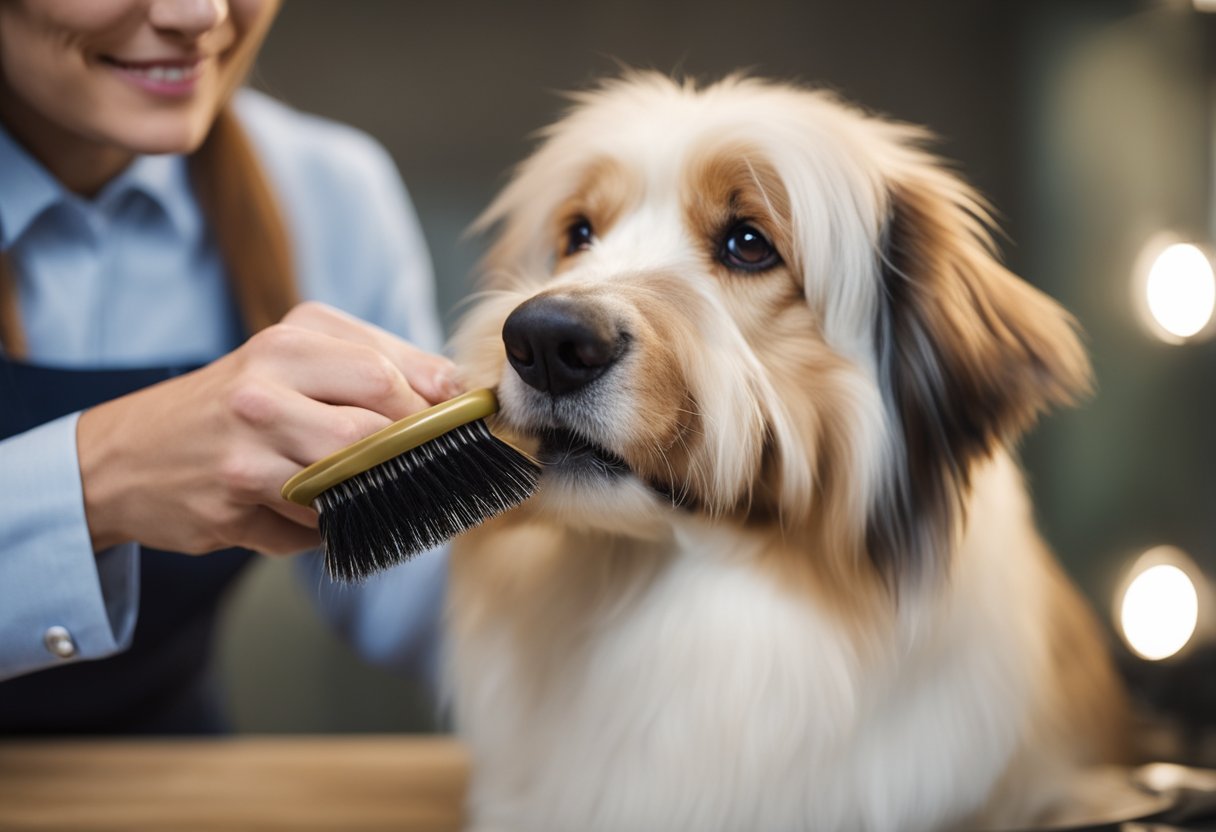
Brushing is an essential part of dog grooming. It helps to remove loose hair, detangle fur, and keep your dog’s coat shiny and healthy. Here are some brushing techniques that you should know.
Detangling Fur
If your dog has long hair, you may need to detangle it before brushing. Start by using a comb to gently work out any knots or mats. Be careful not to pull too hard, as this can be painful for your dog. If the tangle is too big, you may need to use scissors to cut it out.
Removing Loose Hair
Brushing your dog regularly can help to remove loose hair and prevent shedding. Use a slicker brush or a shedding blade to remove dead hair from your dog’s coat. Be gentle when brushing, and avoid pulling too hard, as this can cause discomfort for your dog.
Brushing Different Coat Types
Different dog breeds have different coat types, which require different brushing techniques. For example, dogs with short coats may only need to be brushed once a week, while dogs with long coats may need to be brushed every day. Use a brush that is appropriate for your dog’s coat type, and be gentle when brushing.
Here are some tips for brushing different coat types:
- Short coats: Use a rubber brush or a bristle brush to remove loose hair and dirt.
- Medium coats: Use a slicker brush to remove tangles and mats, and a bristle brush to remove loose hair.
- Long coats: Use a pin brush to remove tangles and mats, and a slicker brush to remove loose hair.
Remember to be patient and gentle when brushing your dog. With the right tools and techniques, you can keep your dog’s coat healthy and beautiful.
Bathing Your Dog
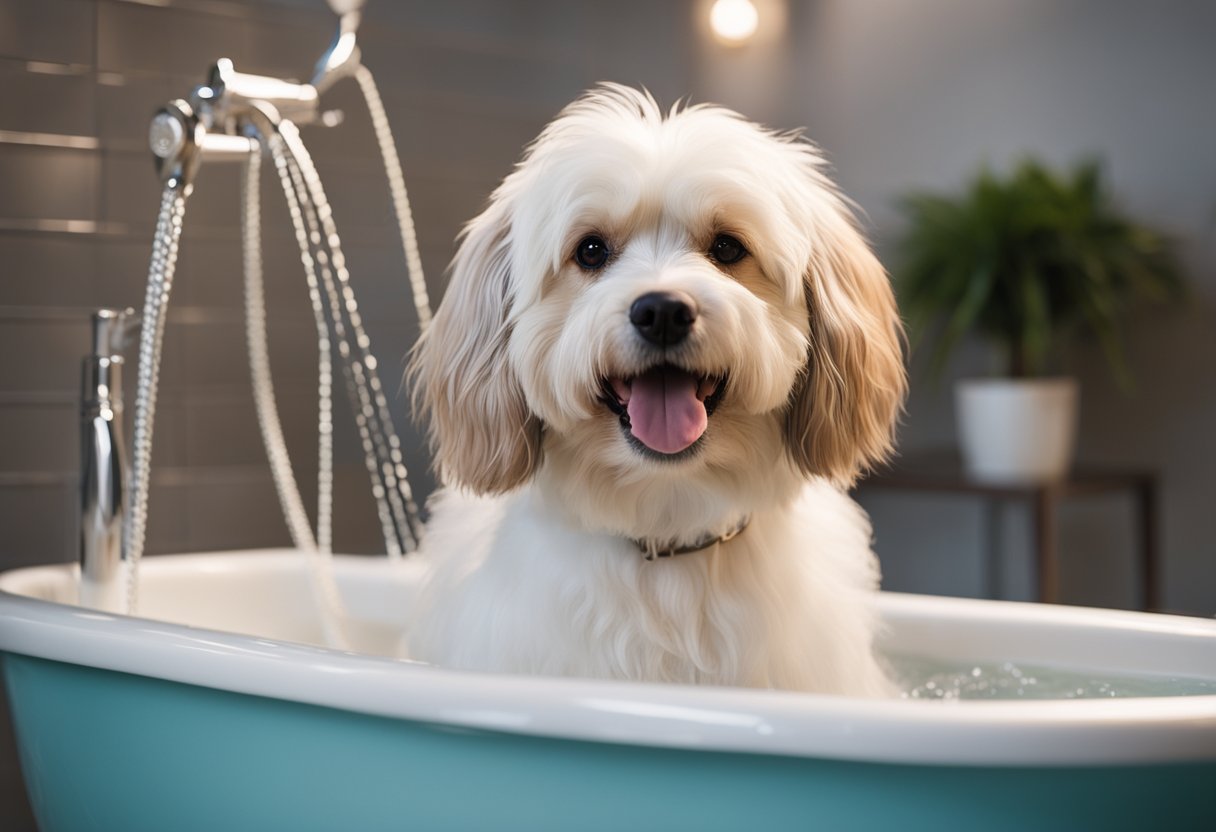
When it comes to bathing your dog, it’s important to use a shampoo that is specifically formulated for dogs. Human shampoos can strip your dog’s coat of its natural oils and cause skin irritation.
Wetting the Coat
Before you start shampooing, thoroughly wet your dog’s coat with lukewarm water. Be sure to avoid getting water in their ears and eyes. You can use a handheld showerhead or a bucket to wet your dog’s coat.
Applying Shampoo
Once your dog’s coat is wet, it’s time to apply the shampoo. Apply a small amount of shampoo to your hands and work it into a lather. Start at the neck and work your way down to the tail, making sure to massage the shampoo into your dog’s coat. Be sure to avoid getting shampoo in their eyes and ears.
Rinsing Thoroughly
After you’ve shampooed your dog’s coat, it’s time to rinse. Rinse your dog thoroughly with lukewarm water, making sure to remove all of the shampoo. If you leave shampoo on your dog’s coat, it can cause skin irritation and itching.
Drying the Coat
Once you’ve rinsed your dog’s coat, it’s time to dry them off. Use a towel to gently pat your dog’s coat dry. Be sure to avoid rubbing the towel vigorously, as this can cause tangles and matting. If your dog has a long coat, you may want to use a blow dryer on a low setting to help speed up the drying process.
Remember, bathing your dog too frequently can strip their coat of its natural oils and cause skin irritation. It’s recommended to bathe your dog every 4-6 weeks, but this can vary depending on your dog’s breed and lifestyle.
Hair Trimming
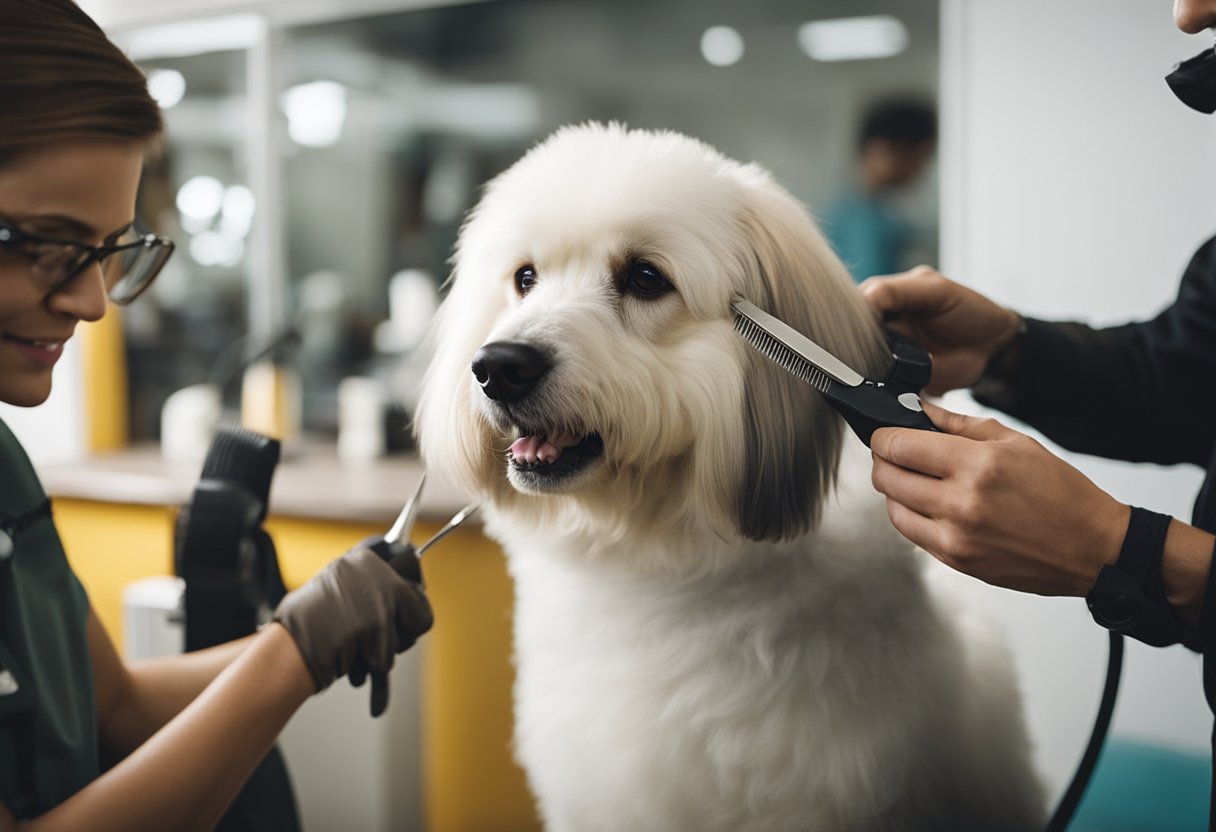
Trimming your dog’s hair is an essential part of grooming. It keeps your dog’s coat healthy, clean, and free of mats. Here are some tips for hair trimming:
Trimming the Body
When trimming your dog’s body hair, start by brushing the hair to remove any tangles or mats. Use a pair of straight grooming shears to cut the hair to the desired length. Make sure to cut the hair in the direction of the hair growth to avoid any unevenness or pulling.
If your dog has a double coat, avoid cutting the undercoat. The undercoat provides insulation and protects your dog from the heat and cold. Instead, focus on trimming the topcoat to keep it neat and tidy.
Cutting Around the Face
Trimming the hair around your dog’s face requires extra care and attention. Use a pair of small scissors to trim the hair around the eyes, nose, and mouth. Make sure to avoid cutting your dog’s skin or whiskers.
If your dog has long hair around the face, consider using a clip to keep the hair out of their eyes. This will not only keep your dog’s face clean but also prevent any eye irritation.
Paw and Pad Care
Trimming the hair around your dog’s paws and pads is important to prevent any dirt, debris, or snow buildup. Use a pair of scissors to trim the hair between the paw pads and around the edges of the paw.
Make sure to also check your dog’s paw pads for any cuts, cracks, or debris. Clean the paw pads with a damp cloth and apply a paw balm or petroleum jelly to keep them moisturized.
In conclusion, hair trimming is an important part of dog grooming. By following these tips, you can keep your dog’s coat healthy, clean, and free of mats.
Nail Clipping

Keeping your dog’s nails trimmed is an important part of their grooming routine. Long nails can be uncomfortable for your dog and may even cause health problems. Here’s how to clip your dog’s nails safely and effectively.
Handling Your Dog’s Paws
Before you start clipping your dog’s nails, it’s important to get them used to having their paws handled. Start by gently touching and holding their paws for short periods of time. Gradually increase the time you spend handling their paws until they are comfortable with it.
Clipping the Nails
When clipping your dog’s nails, it’s important to avoid cutting the quick, which is the pink part of the nail that contains blood vessels and nerves. If you accidentally cut the quick, it can be painful for your dog and may cause bleeding.
To clip your dog’s nails, follow these steps:
- Hold your dog’s paw firmly but gently.
- Use sharp, high-quality nail clippers designed for dogs.
- Position the clippers perpendicular to the nail and make a swift, clean cut.
- Avoid cutting too close to the quick. If you’re unsure where the quick is, it’s better to err on the side of caution and cut less of the nail.
Filing the Nails
After you’ve clipped your dog’s nails, you may want to file them to smooth out any rough edges. You can use a nail file or a rotary tool designed for dog nail filing.
To file your dog’s nails, follow these steps:
- Hold your dog’s paw firmly but gently.
- Use a nail file or rotary tool to file the nail in one direction, away from the quick.
- Be careful not to file too much, as this can cause the nail to bleed.
Remember to reward your dog with treats and praise throughout the grooming process to help them stay calm and relaxed.
Ear and Eye Care
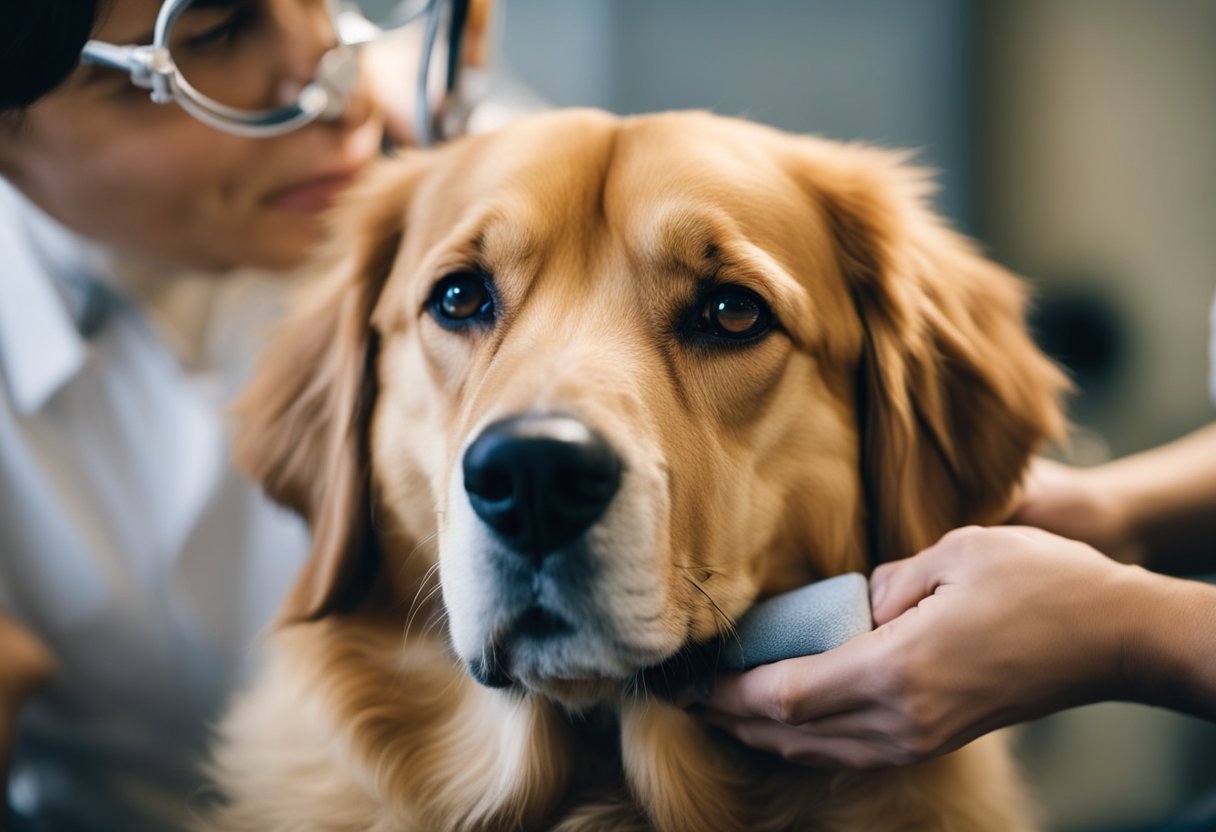
Taking care of your dog’s ears and eyes is important for their health and well-being. In this section, we will cover the basics of ear and eye care for your furry friend.
Cleaning the Ears
Cleaning your dog’s ears is an essential part of their grooming routine. It helps prevent ear infections and keeps your dog’s ears healthy. Here are the steps to follow when cleaning your dog’s ears:
- Start by examining your dog’s ears for any signs of redness, swelling, or discharge. If you notice any of these signs, consult your veterinarian before cleaning your dog’s ears.
- Use a cotton ball or a soft cloth to wipe the inside of your dog’s ear flap. Avoid using cotton swabs as they can push debris further into the ear canal.
- Moisten another cotton ball with a gentle ear cleaning solution. You can find ear cleaning solutions at your local pet store or online. Be sure to follow the instructions on the label.
- Gently wipe the inside of your dog’s ear canal with the moistened cotton ball. Do not insert the cotton ball too far into the ear canal as it can cause injury.
- Repeat the process with a fresh cotton ball until the ear is clean.
Wiping the Eyes
Wiping your dog’s eyes is another important part of their grooming routine. It helps remove any debris or discharge that can cause irritation or infection. Here are the steps to follow when wiping your dog’s eyes:
- Start by examining your dog’s eyes for any signs of redness, swelling, or discharge. If you notice any of these signs, consult your veterinarian before wiping your dog’s eyes.
- Moisten a soft cloth with warm water or a gentle eye cleaning solution. You can find eye cleaning solutions at your local pet store or online. Be sure to follow the instructions on the label.
- Gently wipe the area around your dog’s eyes, including the corners where discharge can accumulate. Use a fresh part of the cloth for each wipe.
- If your dog has tear stains, you can use a tear stain remover solution. Be sure to follow the instructions on the label and avoid getting the solution in your dog’s eyes.
By following these simple steps, you can help keep your dog’s ears and eyes healthy and free from infection.
Dental Hygiene
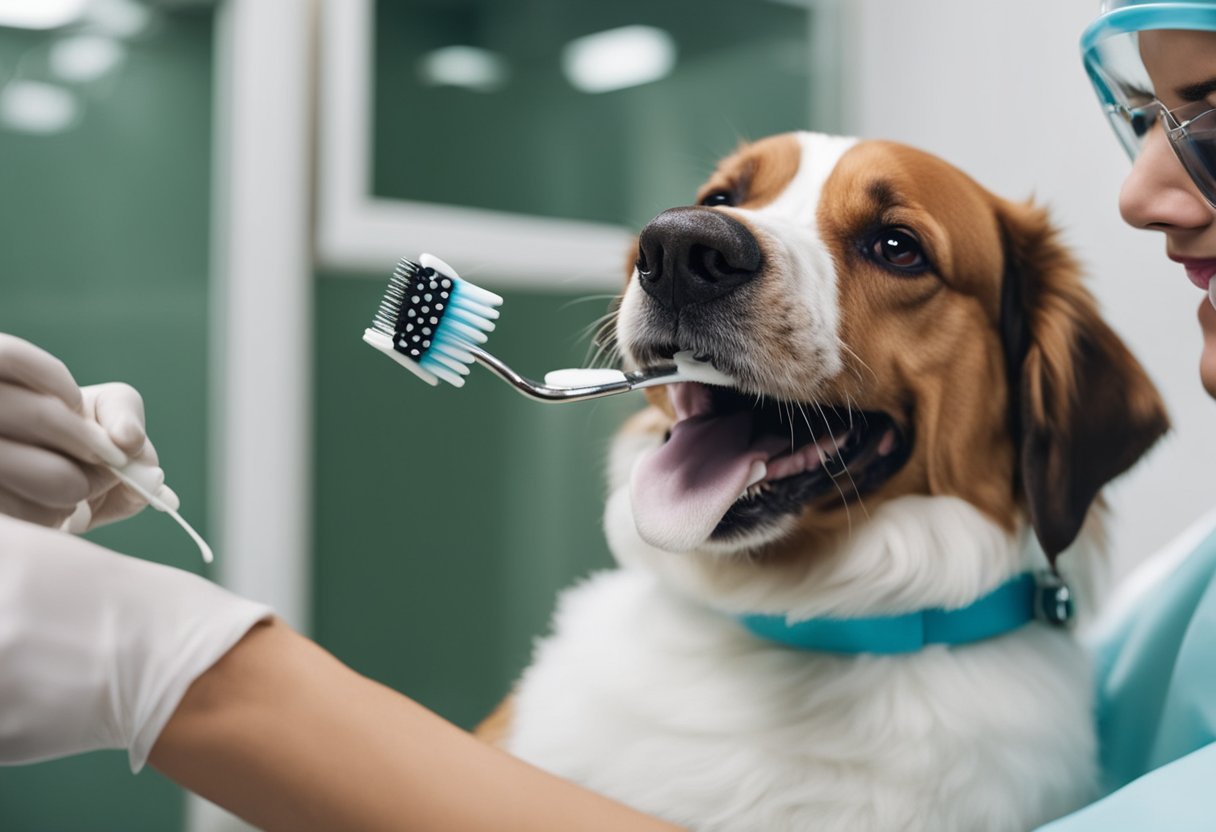
Taking care of your dog’s teeth is important for their overall health. Poor dental hygiene can lead to gum disease, tooth decay, and even organ damage. In this section, we will discuss two ways to maintain your dog’s dental hygiene: brushing their teeth and giving them dental treats.
Brushing Teeth
Brushing your dog’s teeth regularly is the best way to prevent dental problems. You should start brushing your dog’s teeth when they are young so they get used to it. Use a soft-bristled toothbrush and dog toothpaste, which is formulated to be safe for dogs to swallow. Do not use human toothpaste, as it can be harmful to dogs.
To brush your dog’s teeth, follow these steps:
- Hold your dog’s head steady with one hand and lift their lip with the other hand.
- Gently brush their teeth in a circular motion, focusing on the gum line.
- Be sure to brush the back teeth, which are the most susceptible to plaque buildup.
- Reward your dog with a dental treat or praise after brushing.
Brush your dog’s teeth at least twice a week, but ideally every day. If your dog is resistant to brushing, start slowly and gradually increase the frequency over time.
Dental Treats
Dental treats can be a helpful addition to your dog’s dental hygiene routine. They work by scraping away plaque and tartar as your dog chews. Look for dental treats that are specifically designed for your dog’s size and breed.
When choosing dental treats, look for those that have the Veterinary Oral Health Council (VOHC) seal of approval. This means they have been tested and proven to be effective in reducing plaque and tartar.
Remember to always supervise your dog while they are chewing on dental treats to prevent choking or other injuries.
By following these tips, you can help maintain your dog’s dental hygiene and keep their teeth healthy.
Post-Grooming Care
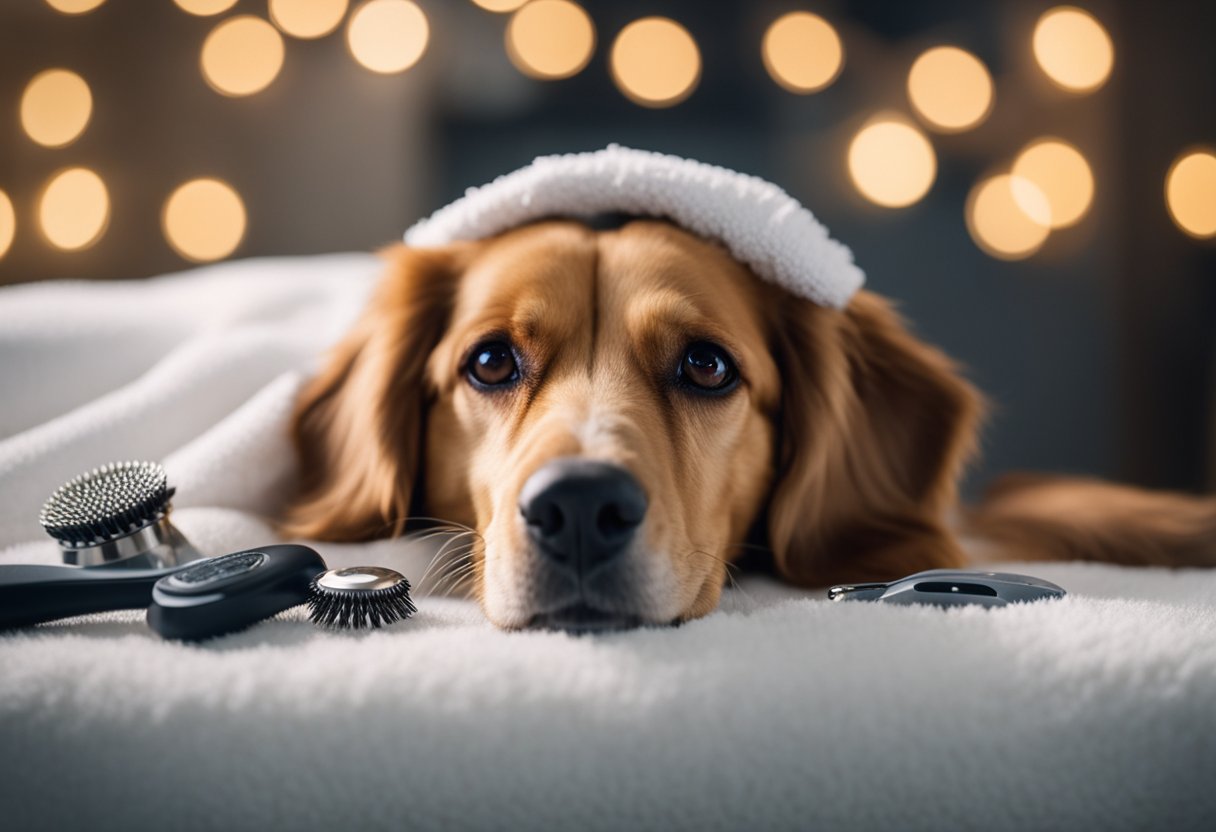
After grooming your dog, it’s important to take a few extra steps to ensure that they stay healthy and comfortable. Here are some tips for post-grooming care.
Rewarding Your Dog
Firstly, it’s a good idea to reward your dog for their good behavior during the grooming process. This can help to reinforce positive behavior and make future grooming sessions easier. You can give your dog a treat or a favorite toy, or simply offer them some extra attention and affection.
Monitoring for Irritation
Next, you should monitor your dog for any signs of irritation or discomfort. Grooming can sometimes cause skin irritation or other issues, so it’s important to keep an eye out for any redness, bumps, or other signs of discomfort. If you notice any issues, you may want to consult with your veterinarian to determine the best course of action.
In addition to monitoring for irritation, you should also keep an eye on your dog’s overall health and well-being. Make sure they are eating and drinking normally, and watch for any changes in behavior or activity level. If you notice any issues, be sure to consult with your veterinarian as soon as possible.
By following these post-grooming care tips, you can help to ensure that your dog stays healthy and comfortable after their grooming session.
Resources
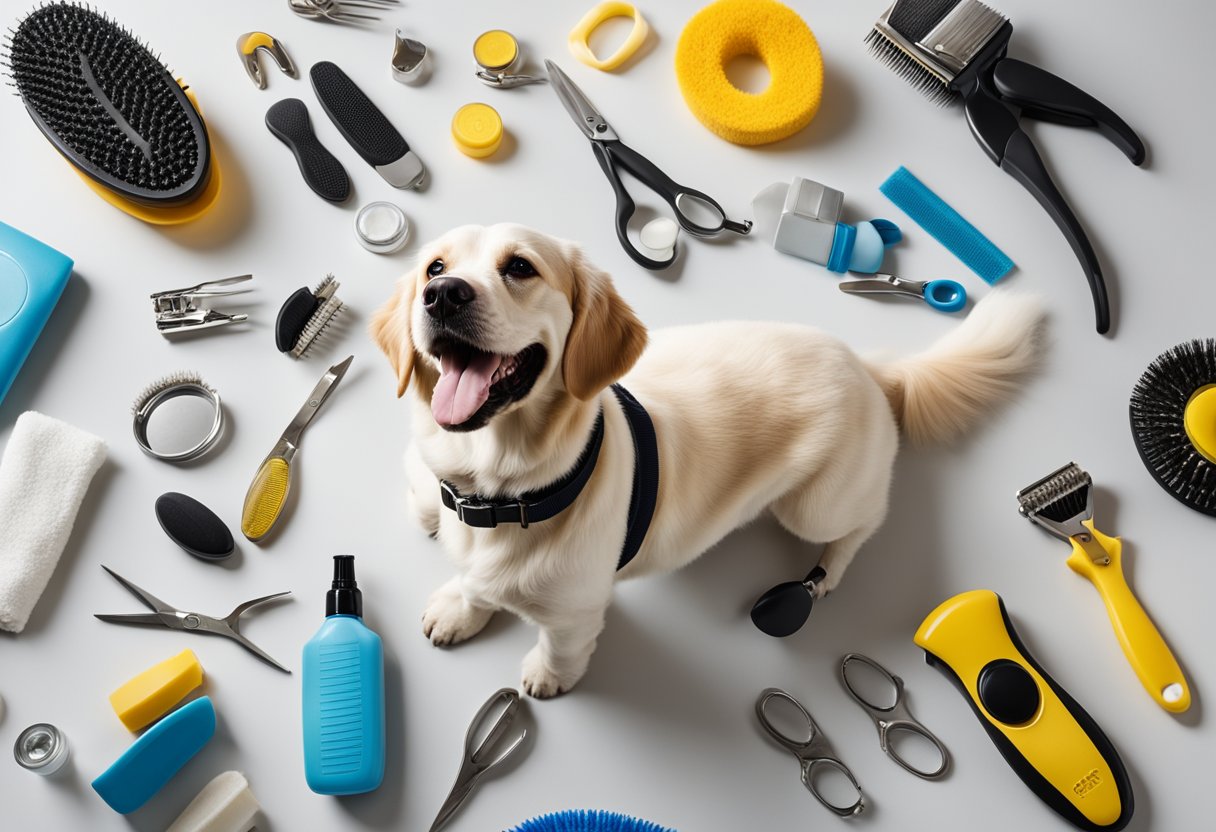
When it comes to grooming your dog, there are plenty of resources available to help you get started. Here are six external links that you may find helpful:
- American Kennel Club: The AKC provides a comprehensive guide on how to groom your dog at home. The guide covers everything from brushing and bathing to nail trimming and ear cleaning.
- The Humane Society of the United States: The Humane Society offers tips on how to groom your dog at home, emphasizing the importance of taking things slowly and carefully.
- Best Friends Animal Society: Best Friends provides a list of dog grooming tips that cover everything from brushing your dog’s teeth to trimming their nails.
- Rover.com: Rover.com offers a guide on how to groom your dog at home, including tips on brushing, shampooing, and nail trimming.
- PetsRadar: PetsRadar provides a vet’s guide to grooming your dog at home, including tips on how to restrain your dog during grooming.
- PetMD: PetMD offers a step-by-step guide on how to groom your dog at home, including tips on how to brush, bathe, and trim your dog’s nails.
By utilizing these resources, you can gain the knowledge and confidence you need to keep your dog looking and feeling their best.
Conclusion
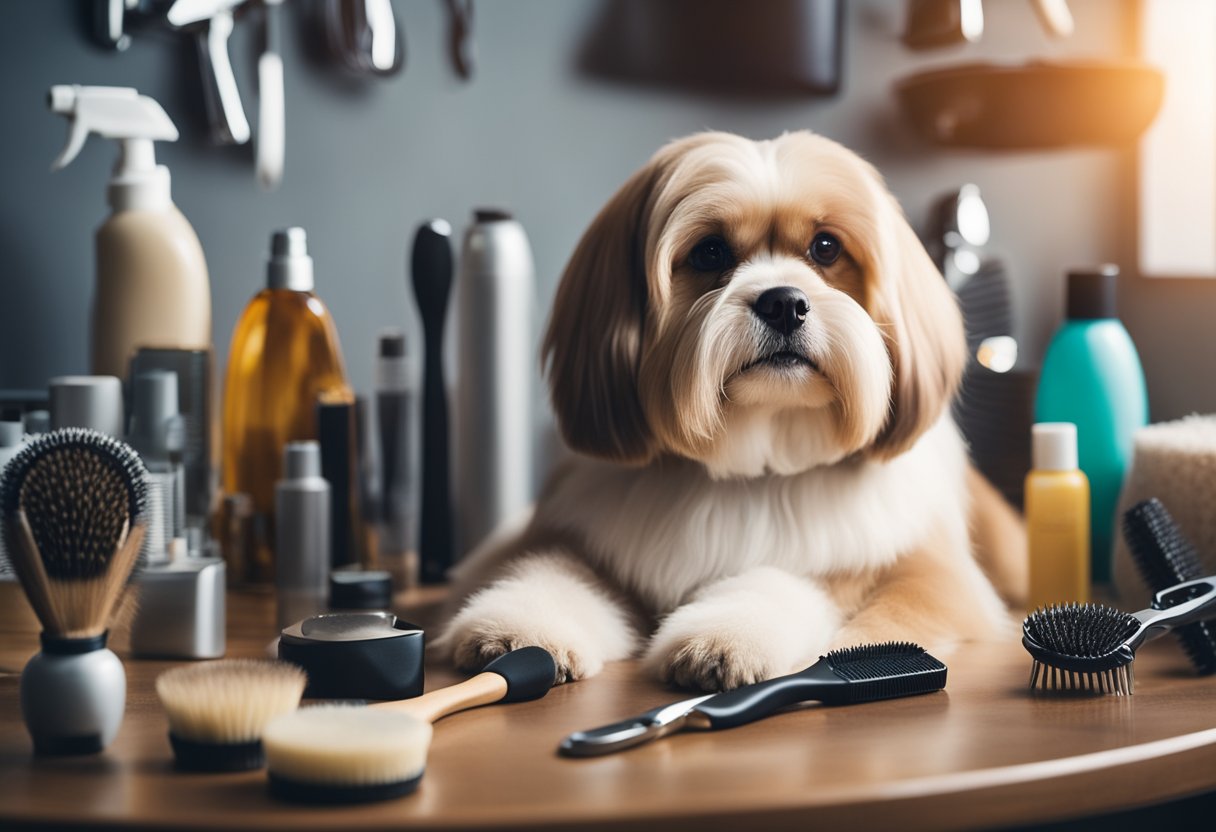
Grooming your dog is an essential part of their overall health and well-being. By following the steps outlined in this article, you can ensure that your dog is clean, comfortable, and looking their best.
Remember to establish a grooming routine that works for both you and your dog. This routine should include regular baths, brushing, nail trimming, and ear cleaning. By sticking to a schedule, you can help prevent health issues and keep your dog looking and feeling great.
When it comes to grooming tools, invest in high-quality products that are safe and effective. This includes brushes, combs, clippers, and shampoos. Take the time to research different brands and consult with your veterinarian if you have any questions or concerns.
Finally, always approach grooming with a positive attitude and plenty of patience. This will help make the experience enjoyable for both you and your furry friend. With a little practice and dedication, you can become a pro at grooming your dog and enjoy the benefits of a happy, healthy pup.
People also ask
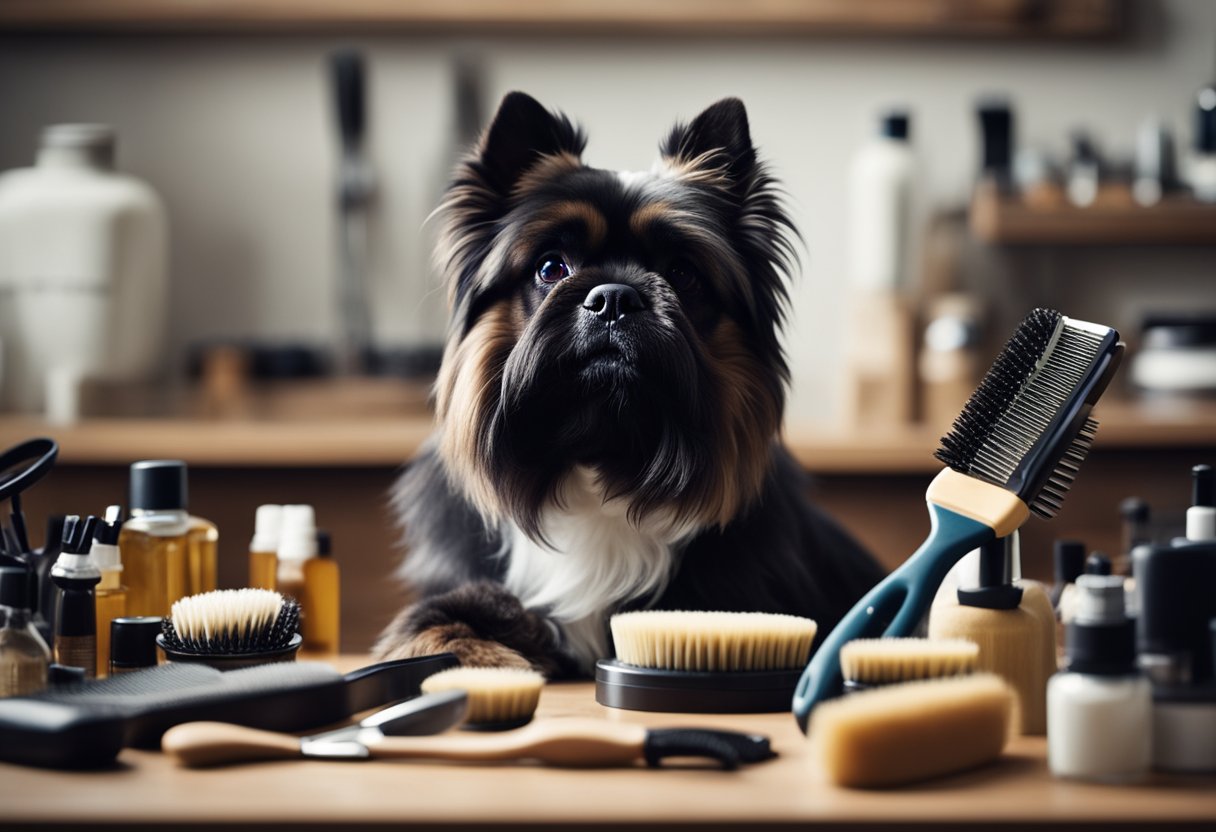
When it comes to grooming your dog, you may have a lot of questions. Here are some of the most frequently asked questions about grooming dogs for beginners:
How do you groom a dog for beginners?
Grooming a dog for the first time can be intimidating, but it doesn’t have to be. Here are some basic steps to follow when grooming your dog:
- Brush your dog’s fur thoroughly to remove any mats or tangles.
- Bathe your dog using a mild shampoo formulated for dogs.
- Dry your dog thoroughly with a towel or blow dryer on a low heat setting.
- Trim your dog’s nails using a pair of dog nail clippers.
- Clean your dog’s ears with a cotton ball and a gentle ear cleaning solution.
- Brush your dog’s teeth using a dog toothbrush and toothpaste.
- Trim your dog’s hair using scissors or clippers, if necessary.
What are the 7 steps of grooming a dog?
The 7 steps of grooming a dog include brushing, bathing, drying, nail trimming, ear cleaning, teeth brushing, and hair trimming. Each step is important to keep your dog healthy and looking good.
Do you groom a dog wet or dry?
It is best to groom a dog when their fur is dry. Wet fur can be more difficult to work with and can lead to uneven haircuts or matting.
How can I trim my dog’s hair at home?
Trimming your dog’s hair at home can be done with scissors or clippers. It is important to use sharp tools and to go slowly to avoid injuring your dog.
Is it OK to cut dog hair with scissors?
Yes, it is okay to cut dog hair with scissors. However, it is important to use sharp scissors and to go slowly to avoid injuring your dog.
Is it OK to cut dogs hair?
Yes, it is okay to cut a dog’s hair, but it is important to do it properly to avoid injury or discomfort to your dog. It is recommended to use sharp scissors or clippers and to go slowly.
Should you brush or comb a dog first?
It is best to brush your dog’s fur first to remove any mats or tangles. Combing can be done afterwards to smooth out the fur.
Do dog groomers wash or cut first?
Dog groomers typically wash the dog first, then trim the hair. This helps to remove any dirt or debris from the fur and makes it easier to see what needs to be trimmed.
Frequently Asked Questions
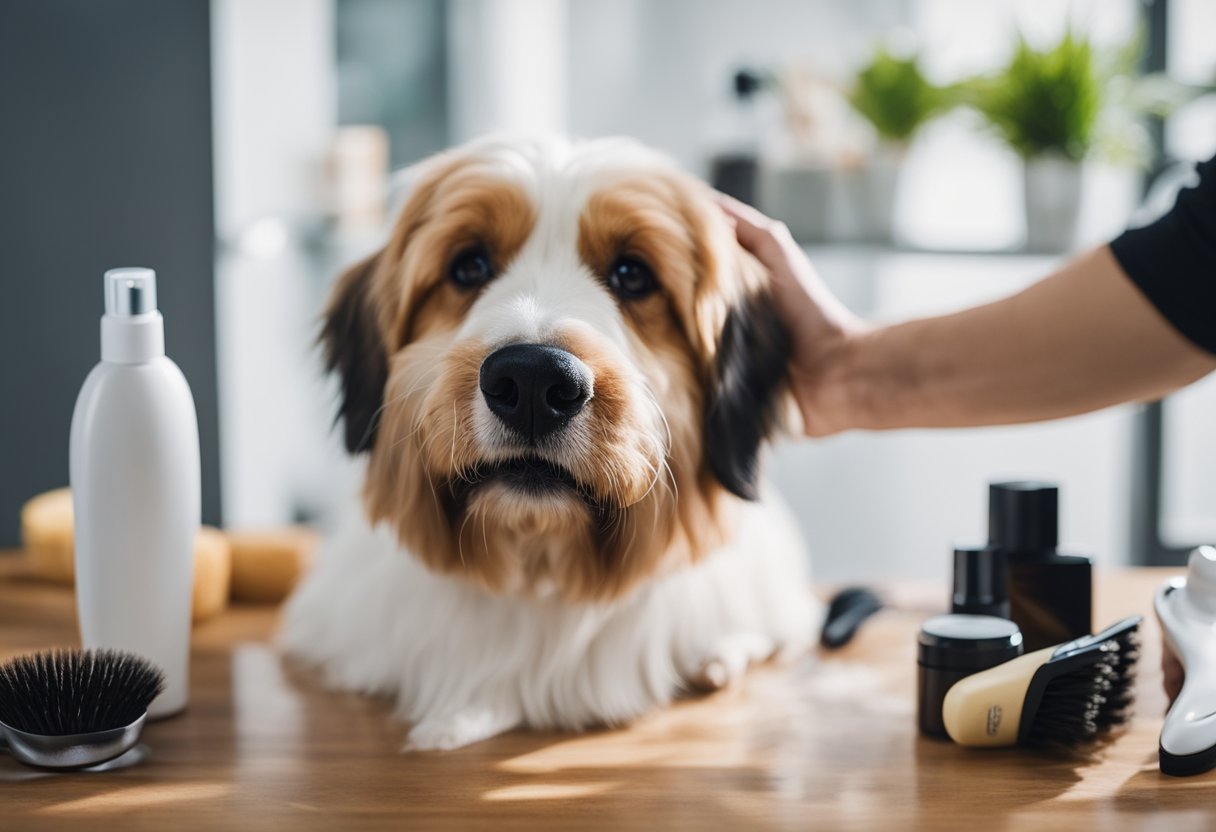
What essential tools do I need to groom my dog at home?
To groom your dog at home, you will need some essential tools, including a brush or comb, scissors, nail clippers, and shampoo. You should choose the brush or comb based on your dog’s coat type. For example, a slicker brush is suitable for long-haired dogs, while a bristle brush is best for short-haired dogs. Additionally, you can use scissors to trim the hair around your dog’s eyes, ears, and paws. Make sure to choose scissors that are specifically designed for grooming dogs.
Can you explain the step-by-step process for grooming a dog?
Grooming a dog typically involves several steps. First, brush or comb your dog’s coat to remove any tangles or mats. Then, trim your dog’s nails using nail clippers. After that, clean your dog’s ears with a cotton ball and ear cleaner. Next, give your dog a bath using dog shampoo and warm water. Rinse thoroughly and dry your dog with a towel. Finally, use scissors to trim any excess hair around your dog’s eyes, ears, and paws.
What are the best techniques for grooming a dog with matted hair?
If your dog’s hair is matted, it’s important to be gentle when grooming them. Use a slicker brush to loosen the mats, starting at the edges and working your way inward. If the mats are severe, you may need to use scissors to cut them out. Be careful not to cut your dog’s skin, and use the scissors only to cut the mats, not the hair.
How should I use scissors safely when grooming my dog?
When using scissors to groom your dog, it’s essential to be careful and use them safely. Hold the scissors with the blades pointing away from your dog and use your other hand to hold the hair you’re cutting. Cut the hair in small sections, and be careful not to cut too much at once. Additionally, make sure to use scissors that are specifically designed for grooming dogs.
What are the key steps for a beginner to groom a dog at home?
If you’re a beginner, the key steps for grooming your dog at home include brushing or combing your dog’s coat, trimming their nails, cleaning their ears, giving them a bath, and trimming any excess hair around their eyes, ears, and paws. It’s essential to be gentle and patient when grooming your dog, especially if they’re not used to it.
Should I groom my dog when its coat is wet or dry?
It’s generally best to groom your dog when their coat is dry. Wet hair can be more challenging to work with and can make tangles or mats worse. If you need to give your dog a bath before grooming them, make sure to dry them thoroughly with a towel before starting the grooming process.
